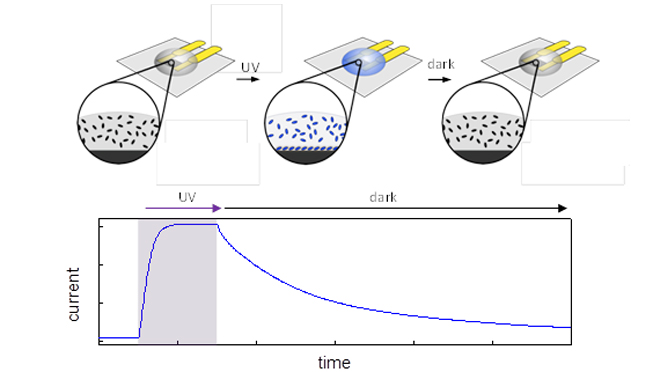Researchers from the University of Strasbourg & CNRS (France), in collaboration with Humboldt University of Berlin and DWI – Leibniz Institute for Interactive Materials/RWTH Aachen University (Germany), have demonstrated that graphene devices can be used to monitor in real time the dynamics of molecular self-assembly at the solid/liquid interface. Their results have been published in Nature Communications.
Molecular self-assembly on surfaces is a powerful strategy to provide substrates with programmable properties. Understanding the dynamics of the self-assembly process is crucial to master surface functionalization. However, real-time monitoring of molecular self-assembly on a given substrate is complicated by the challenge to disentangle interfacial and bulk phenomena.
Cutting-edge scanning probe microscopy techniques, such as scanning tunneling microscopy (STM), have been used to monitor the dynamics of self-assembly at the solid/liquid interface, but thus far only in small populations of (less than 1,000) molecules and with a low time resolution (from 1 to 10 seconds).
In the present study, the researchers have shown that a transistor incorporating graphene – a two-dimensional (2D) material that is highly sensitive to changes in its environment – can be used as a highly sensitive detector to track the dynamics of molecular self-assembly at the graphene/solution interface.
A photoswitchable spiropyran molecule, equipped with an anchoring group and able to reversibly interconvert (switch) between two different forms (isomer) by light, was investigated. When a droplet of a solution of this compound is casted on graphene, the spiropyran isomer does not form any ordered adlayer on the surface. In strong contrast, upon ultraviolet (UV) irradiation, the molecules in solution switch to the planar merocyanine isomer that forms a highly ordered layer on the graphene surface. When the UV light is turned off, the molecules revert to their initial non-planar spiropyran form and the ordered adlayer desorbs. Importantly, the merocyanine monolayer induces a distinct change in the electrical conductance of graphene and hence it is possible to monitor the dynamics of its formation and desorption by simply recording the electrical current flowing through graphene over time.
This simple and robust platform based on a graphene device allows the real-time monitoring of the complex dynamic process of molecular self-assembly at the solid/liquid interface. The electrical detection, which is highly sensitive, ultra-fast, practical, reliable and non-invasive, provides insight into the dynamics of several billions of molecules covering large areas (0.1 × 0.1 mm2) with a high temporal resolution (100 ms). Furthermore, the ultra-high surface sensitivity of graphene permits to disentangle the dynamics of different processes occurring simultaneously at the solid/liquid interface and in the supernatant solution. This strategy holds a great potential for applications in (bio)chemical sensing and diagnostics.
Graphene transistors for real-time monitoring molecular self-assembly dynamics
Marco Gobbi*, Agostino Galanti, Marc-Antoine Stoeckel, Bjorn Zyska, Sara Bonacchi, Stefan Hecht & Paolo Samorì*
Nature Communications, 2020, 11, 4731

